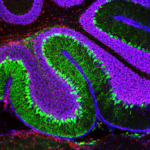MC3 Research Labs
Bellamkonda Lab
The Bellamkonda Lab explores the interplay of biomaterials and the human nervous system with the goal of finding new and improved treatments for neurological disorders and cancers. The team’s work includes engineering new devices and therapies for brain tumors, modulating the immune system to encourage peripheral and central nervous system repair, and designing more effective biomaterials and brain-machine interfaces. Among the lab’s current projects is an effort to improve cellular therapy for traumatic brain injury (TBI) by delivering therapeutic stem cells in a specially designed carrier gel that creates an “immune-privileged” microenvironment within the brain, thereby protecting the transplanted cells from attack by the body’s immune system.
Read more on the Bellamkonda Lab website.
Chilkoti Lab
The Chilkoti group carries out research in two areas: (1) Biomolecular Materials, with a focus on genetically encoded stimulus responsive peptide polymers and fusion proteins for application in protein purification and drug delivery; and (2) Biointerface Science, with a focus on protein-polymer conjugates, the development of low-cost, point-of-care clinical diagnostics, and plasmonic biosensors.
Read more on the Chilkoti Lab website.
Collier Lab
The Collier Group is designing new materials such as nanofibers, gels, and nanoparticles that are capable of engaging the immune system, in order to treat a range of diseases and conditions. In one set of projects, they are designing new vaccines for diseases such as malaria, tuberculosis, cancer, and influenza, none of which are currently treatable with highly effective, long-lasting vaccines. Other work is focused on designing gel materials for the delivery of cells and the healing of diseased or damaged tissues.
Read more on the Collier Lab website.
Gersbach Lab
The Gersbach Lab is dedicated to applying innovative methods in molecular and genetic engineering to regenerative medicine, treating genetic disease, and enhancing the understanding of fundamental biological processes. In particular, their research aims to develop new technologies to modify genome sequences, epigenomic regulation, and cellular gene networks in a precise and targeted manner. These new technologies are then applied to correction of genetic diseases, directing cell differentiation, tissue regeneration, drug target discovery, or answering fundamental biological questions regarding gene regulation and genome structure and function. Examples of technologies used in their research include genome and epigenome editing with CRISPR/Cas9 and other DNA-targeting systems, protein engineering, directed evolution, genetic reprogramming, and optogenetics
Read more on the Gersbach Lab website.
Robertson Research Lab

The Robertson Research Lab investigates novel uses of cord blood cells for future clinical applications. Our group currently focuses on treatments for leukodystrophies and lysosomal storage disorders among others. Some of our work demonstrates the ability of cultured cord blood cells to increase re-myelination after insult to brain nerve tissue in mice. Our work includes culturing cell subsets from cord blood and characterizing with in- vitro and in-vivo studies to determine mechanism of action.
We have recently expanded the lab and moved into newly renovated laboratory space at the Chesterfield Building in Durham. We now have multiple cell culture rooms and additional bench space to accommodate future growth.
Read more on the Robertson Research Lab website.
Segura Lab
Research in the Segura Laboratory focuses on engineering hydrogel biomaterials to support the formation of a reparative niche within damaged or diseased sites of the body. Their gels aid in cell migration and proliferation, as well as serve as a platform for delivery of regenerative factors. They see remarkable outcomes when their biomaterials are applied to ischemic tissues, such as brain after stroke and chronic ulcers in skin, in part due to their gel’s ability to form a “space-filling vascular plexus” that not only helps to speed up healing, but also lays the groundwork for recruitment of endogenous stem or progenitor cells. This fosters regeneration of tissue rather than scarring.
Read more on the Segura Lab website.
Varghese Lab
The Lab’s research lies at the interface of cell and molecular biology, engineering, physical sciences, material science, and medicine. Specifically, they are interested in understanding the effect of physicochemical cues of the microenvironment on various cellular behaviors leading to stem cell commitment, tissue repair and homeostasis, or disease progression. Their approach entails the development of bioengineered platforms including multifunctional biomaterials emulating physicochemical properties of the ECM and stem cell-derived organoids that recapitulate key features of human tissues and diseases. Unique to their approach is employing such platforms to unravel the underlying molecular mechanisms. Moving forward, they harness these understandings to develop novel therapeutics regimens, including cell transplantation, activation of endogenous cells, and therapeutic interventions targeting the microenvironment and signaling pathways. Examples of ongoing research activities in their laboratory involve developing: functional biomaterials such as self-healing materials, technologies to improve stem cell based therapies including activating endogenous stem cells, engineered functional tissue grafts, and organ-on-a-chip systems.
Read more on the Varghese Lab website.